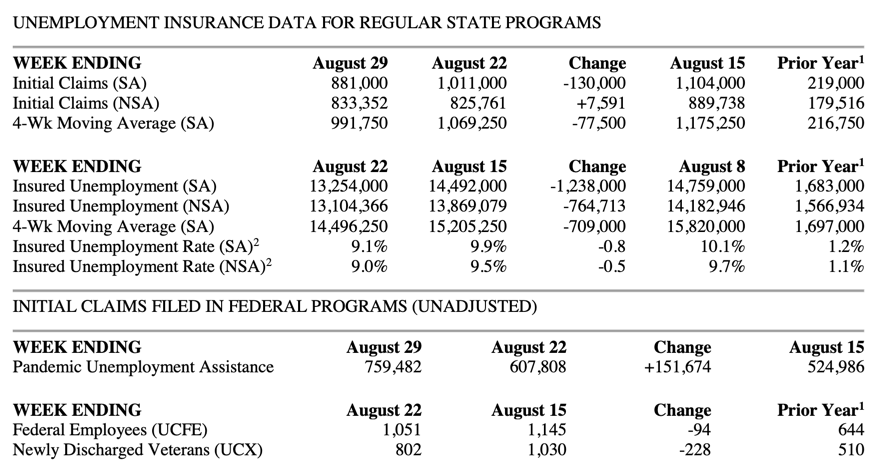Fixing the jobless claims numbers
The fix
I am writing this just before the release of the US jobless claims data series. And for weeks now, I have been telling you that the unemployment claim series was distorted by a multiplicative seasonal factor. See here and here.
This week’s data are different. That’s because, last week, the US Department of Labor told us it was going to fix the problem.
Here’s how they put it in the release last Thursday:
REVISION TO SEASONAL ADJUSTMENT FACTORS
Beginning with the Unemployment Insurance (UI) Weekly Claims News Release issued Thursday, September 3, 2020, the methodology used to seasonally adjust the national initial claims and continued claims will reflect additive factors as opposed to multiplicative factors.
Seasonal adjustment factors can be either multiplicative or additive. A multiplicative seasonal effect is assumed to be proportional to the level of the series. A sudden large increase in the level of the series will be accompanied by a proportionally large seasonal effect. In contrast, an additive seasonal effect is assumed to be unaffected by the level of the series. In times of relative economic stability, the multiplicative option is generally preferred over the additive option. However, in the presence of a large level shift in a time series, multiplicative seasonal adjustment factors can result in systematic over- or under-adjustment of the series; in such cases, additive seasonal adjustment factors are preferred since they tend to more accurately track seasonal fluctuations in the series and have smaller revisions.
Prior to September 2020, the seasonally adjusted unemployment insurance claims series used multiplicative seasonal adjustment factors. Starting in September Bureau of Labor Statistics staff, who provide the seasonal adjustment factors, specified these series as additive. In accordance with the usual practice, the seasonal adjustment models and factors will be reviewed at the beginning of each calendar year, when prior years of seasonally adjusted estimates will be subject to revision.
Translation: All of the seasonally-adjusted numbers the media have been reporting are wrong. The Department of Labor is going to retroactively fix all of the prints at the beginning of 2021. But the numbers that come out today and going forward will not be distorted by seasonality like the previous pandemic numbers have been.
The numbers
We got a seasonally-adjusted number of 881,000. This is much closer to the unadjusted number than recent claims prints have been.

Unfortunately, there is no apples-to-apples comparison for previous weeks because the data have yet to be revised. So, the decline from 1,011,000 to 881,000 claims this week isn’t representative of what is happening on the ground. The raw number increase of just under 7,000 claims is more suggestive of what’s occurred. In essence, we are holding firm at over 800,000 jobless claims now.
My view
Last month, I told you that a “steady-state post-recessionary economy is associated with maybe 400,000 initial claims, about half today’s levels. If we don’t get down to that level quickly, expect expectations on consumption, capital investment and GDP growth to crumble for Q3 and especially Q4. If the downward trend in claims stops and reverses, the economic implications would be even worse. I wouldn’t rule out a negative print for Q4 GDP.”
I would stand by that framing. 800,000 is double the level I want to see. And so, we can’t expect grand things from the jobs data tomorrow or next month. The US recovery has stalled, in my view. And the initial claims data are the best real-time indicator of this fact.
Comments are closed.